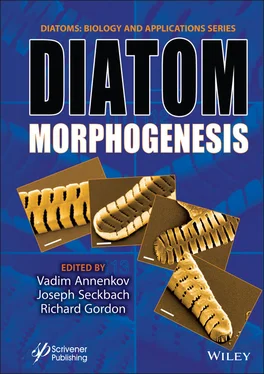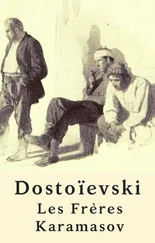Diatom Morphogenesis
Здесь есть возможность читать онлайн «Diatom Morphogenesis» — ознакомительный отрывок электронной книги совершенно бесплатно, а после прочтения отрывка купить полную версию. В некоторых случаях можно слушать аудио, скачать через торрент в формате fb2 и присутствует краткое содержание. Жанр: unrecognised, на английском языке. Описание произведения, (предисловие) а так же отзывы посетителей доступны на портале библиотеки ЛибКат.
- Название:Diatom Morphogenesis
- Автор:
- Жанр:
- Год:неизвестен
- ISBN:нет данных
- Рейтинг книги:5 / 5. Голосов: 1
-
Избранное:Добавить в избранное
- Отзывы:
-
Ваша оценка:
- 100
- 1
- 2
- 3
- 4
- 5
Diatom Morphogenesis: краткое содержание, описание и аннотация
Предлагаем к чтению аннотацию, описание, краткое содержание или предисловие (зависит от того, что написал сам автор книги «Diatom Morphogenesis»). Если вы не нашли необходимую информацию о книге — напишите в комментариях, мы постараемся отыскать её.
A unique book presenting the range of silica structures formed by diatoms, theories and hypotheses of how they are made, and applications to nanotechnology by use or imitation of diatom morphogenesis.
Audience
Diatom Morphogenesis — читать онлайн ознакомительный отрывок
Ниже представлен текст книги, разбитый по страницам. Система сохранения места последней прочитанной страницы, позволяет с удобством читать онлайн бесплатно книгу «Diatom Morphogenesis», без необходимости каждый раз заново искать на чём Вы остановились. Поставьте закладку, и сможете в любой момент перейти на страницу, на которой закончили чтение.
Интервал:
Закладка:
[2.70] Kadir, T., Boukerroui, D., Brady, M., An analysis of the scale saliency algorithm [Technical report TR-2264-03] , Robotics Research Laboratory, Department of Engineering Science, University of Oxford, Oxford, UK, 2003.
[2.71] Klimontovich, Y.L., Entropy, information and ordering criteria in open systems, in: Nonlinear Dynamics in the Life and Social Sciences , vol. 320, W. Sulis and I. Trofimova (Eds.), pp. 13–32, IOS Press, Amsterdam, 2001.
[2.72] Koenderink, J.J., vanDoorn, A.J., Kappers, A.M.L., Todd, J.T., The visual contour in depth. Percept. Psychophys ., 59, 6, 828–838, 1997.
[2.73] Korabel, N. and Barkai, E., Pesin-type identity for intermittent dynamics with a zero Lyaponov exponent. Phys. Rev. Lett ., 102, 5, 050601, 2009.
[2.74] Korabel, N. and Barkai, E., Separation of trajectories and its relation to entropy for intermittent systems with a zero Lyapunov exponent. Phys. Rev. E , 82, 016209, 2010.
[2.75] Kotzsch, A., Pawolski, D., Milentyev, A., Shevchenko, A., Scheffel, A., Poulsen, N., Shevchenko, A., Kroger, N., Biochemical composition and assembly of biosilica-associated insoluble organic matrices from the diatom Thalassiosira pseudonana. J. Biol. Chem ., 291, 10, 4982–4997, 2016.
[2.76] Kroger, N., Prescribing diatom morphology: toward genetic engineering of biological nanomaterials. Curr. Opin. Chem. Biol ., 11, 6, 662–669, 2007.
[2.77] Kuptsov, P.V. and Parlitz, U., Theory and computation of covariant Lyapunov vectors. J. Nonlinear Sci ., 22, 5, 727–762, 2012.
[2.78] Laffargue, T., Tailleur, J., van Wijland, F., Lyapunov exponents of stochastic systems-from micro to macro. J. Stat. Mech.-Theory Exp ., 2016, 034001, 2016.
[2.79] Lee, J.-H. and Chang, M., Morphological variations of the marine diatom genus Actinoptychus in the coastal waters of Korea. Algae , 11, 4, 365–374, 1996.
[2.80] Leeuwenberg, E., The perception of assimilation and brightness contrast as derived from code theory. Percept. Psychophys ., 32, 4, 345–352, 1982.
[2.81] Lenoci, L. and Camp, P.J., Self-assembly of peptide scaffolds in biosilica formation: computer simulations of a coarse-grained model. J. Am. Chem. Soc ., 128, 31, 10111–10117, 2006.
[2.82] Lenoci, L. and Camp, P.J., Diatom structures templated by phase-separated fluids. Langmuir, 24, 1, 217–223, 2008.
[2.83] Libbrecht, K. and Rasmussen, P., The Snowflake, Winter’s Secret Beauty , Voyageur Press, Stillwater, Minnesota, USA, 2003.
[2.84] Lin, S.K., Correlation of entropy with similarity and symmetry. J. Chem. Inf. Comput. Sci., 36, 3, 367–376, 1996.
[2.85] Losic, D. (Ed.), Diatom Nanotechnology: Progress and Emerging Applications , Royal Society of Chemistry, London, 2018.
[2.86] Loy, G. and Eklundh, J.O., Detecting symmetry and symmetric constellations of features. Lect. Notes Comput. Sci ., 3952, 508–521, 2006.
[2.87] Ludwig, W., Das Recht-Links-Problem im Tierreich und beim Menschen: Mit einem Anhang: Rechts-Links-Merkmale der Pflanzen [The Right-Left Problem in the Animal Kingdom and in Humans: With an Appendix: Right-Left Characteristics of Plants] [German] , Verlag von Julius Springer, Berlin, Germany, 1932.
[2.88] Lyapunov, A.M., The general problem of the stability of motion [Reprinted translation of: Probleme generale de la stabilite du mouvement. Commun. Soc. Math. Kharkov , 2, 1892, 265–272, 1992.
[2.89] MacArthur, B.D., Sanchez-Garcia, R.J., Anderson, J.W., Symmetry in complex networks. Discrete Appl. Math ., 156, 18, 3525–3531, 2008.
[2.90] MacDonald, J.D., On the structure of the diatomaceous frustule, and its genetic cycle. Ann. Mag. Nat. Hist. Ser., 4 , 3, 1–8, 1869.
[2.91] Maini, P.K., Baker, R.E., Chuong, C.M., Developmental biology. The Turing model comes of molecular age. Science , 314, 5804, 1397–1398, 2006.
[2.92] Maini, P.K., Woolley, T.E., Baker, R.E., Gaffney, E.A., Lee, S.S., Turing’s model for biological pattern formation and the robustness problem. Interface Focus , 2, 4, 487–496, 2012.
[2.93] Mann, D.G., Specifying a morphogenetic model for diatoms: an analysis of pattern faults in the Voigt zone. Nova Hedwig ., Suppl., 130, 97–117, 2006.
[2.94] Mather, K., Genetical control of stability in development. Heredity , 7, 3, 297–336, 1953.
[2.95] Matsumoto, E.A. and Kamien, R.D., Elastic-instability triggered pattern formation. Phys. Rev. E , 80, 2, 15, #021604, 2009.
[2.96] Meinhardt, H. and Gierer, A., Pattern formation by local self-activation and lateral inhibition. Bioessays , 22, 8, 753–760, 2000.
[2.97] Mihelich, M., Dubrulle, B., Paillard, D., Herbert, C., Maximum entropy production vs. Kolmogorov-Sinai entropy in constrained ASEP model. Entropy , 16, 2, 1037–1046, 2014.
[2.98] Mitchell, J.G., Whence is the diversity of diatom frustules derived?, in: Diatom Nanotechnology: Progress and Emerging Applications , D. Losic (Ed.), pp. 1–13, Royal Society of Chemistry, Cambridge, 2018.
[2.99] Nesterenko, A.M., Kuznetsov, M.B., Korotkova, D.D., Zaraisky, A.G., Morphogene adsorption as a Turing instability regulator: Theoretical analysis and possible applications in multicellular embryonic systems. PLoS One , 12, 2, e0171212, 2017.
[2.100] Ornstein, D.S., Ergodic theory, randomness, and “chaos”. Science , 243, 4888, 182–187, 1989.
[2.101] Oseledec, V.I., A multiplicative ergodic theorem. Lyapunov characteristic numbers for dynamical systems. Trans. Moscow Math. Soc ., 19, 197–231, 1968.
[2.102] Palmer, A.R., Symmetry breaking and the evolution of development. Science , 306, 5697, 828–833, 2004.
[2.103] Palmer, A.R. and Strobeck, C., Fluctuating asymmetry analyses revisited , Oxford University Press, Oxford, UK, 2003.
[2.104] Pappas, J.L., Geometry and topology of diatom shape and surface morphogenesis for use in applications of nanotechnology. J. Nanosci. Nanotechnol ., 5, 1, 120–130, 2005.
[2.105] Pappas, J.L., Theoretical morphospace and its relation to freshwater gomphonemoid-cymbelloid diatom (Bacillariophyta) lineages. J. Biol. Syst ., 13, 4, 385–398, 2005.
[2.106] Pappas, J.L., More on theoretical morphospace and its relation to freshwater gomphonemoid-cymbelloid diatom (Bacillariophyta) lineages. J. Biol. Syst ., 16, 1, 119–137, 2008.
[2.107] Pappas, J.L., Multivariate complexity analysis of 3D surface form and function of centric diatoms at the Eocene-Oligocene transition. Mar. Micropaleontol ., 122, 67–86, 2016.
[2.108] Pappas, J.L. and Miller, D.J., A generalized approach to the modeling and analysis of 3D surface morphology in organisms. PLoS One , 8, 10, e77551, 2013.
[2.109] Parkinson, J., Brechet, Y., Gordon, R., Centric diatom morphogenesis: A model based on a DLA algorithm investigating the potential role of microtubules. Biochim. Biophys. Acta - Mol. Cell Res ., 1452, 1, 89–102, 1999.
[2.110] Pesin, J.B., Families of invariant manifolds corresponding to nonzero characteristic exponents. Math. USSR-Izv ., 10, 1261–1305, 1976.
[2.111] Pfitzer, E., Untersuchungen uber Bau und Entwicklung der Bacillariaceen (Diatomaceen) [Studies on construction and development of Bacillariaceae (Diatomaceae)] [German], in: Botanische Abhandlungen aus dem Gebiete der Morphologie und Physiologie [Botanical Treatises in the Field of Morphology and Physiology] , vol. [i]-vi, J.L.E.R. von Hanstein (Ed.), pp. 1–189, 186 pls, Adolph Marcus, Bonn, Germany, 1871.
[2.112] Pfitzer, E., Die Bacillariaceen (Diatomaceae) [Bacillariaceae (Diatomaceae)] [German], in: Encyklopaedie der Naturwissenschaften. I. Abteilung. I. Thiel: Handbuch der Botanik , vol. 2, A. Schenk (Ed.), pp. 403–445, Verlag von Eduard Trewendt, Breslau, 1882.
Читать дальшеИнтервал:
Закладка:
Похожие книги на «Diatom Morphogenesis»
Представляем Вашему вниманию похожие книги на «Diatom Morphogenesis» списком для выбора. Мы отобрали схожую по названию и смыслу литературу в надежде предоставить читателям больше вариантов отыскать новые, интересные, ещё непрочитанные произведения.
Обсуждение, отзывы о книге «Diatom Morphogenesis» и просто собственные мнения читателей. Оставьте ваши комментарии, напишите, что Вы думаете о произведении, его смысле или главных героях. Укажите что конкретно понравилось, а что нет, и почему Вы так считаете.












